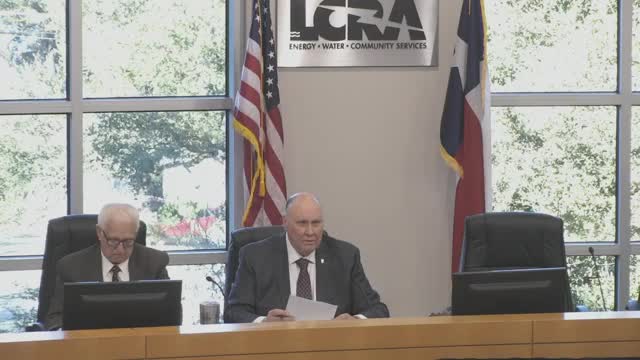Lower Colorado River Authority details wildfire mitigation steps for transmission lines
January 25, 2025 | Lower Colorado River Authority (LCRA), Departments and Agencies, Executive, Texas
This article was created by AI summarizing key points discussed. AI makes mistakes, so for full details and context, please refer to the video of the full meeting. Please report any errors so we can fix them. Report an error »

A staff member for the Lower Colorado River Authority (LCRA) told the board that the authority operates multiple measures to prevent, detect and mitigate wildfire risk along its transmission system, including monitoring, vegetation management and selective outages.
LCRA described why those actions matter: wildfire risk can threaten transmission structures and nearby property. “Safety is our top priority and a core value,” the staff member said, describing transmission design and inspection practices and routine vegetation management around power lines.
According to the staff member, transmission designers and crews work to make infrastructure resilient to high winds and reduce fire risk. System operations and control center (SOC) staff monitor weather and wildfire conditions and collaborate with field operators to determine whether “preemptive outages are needed to prevent fire” and to coordinate with the Electric Reliability Council of Texas (ERCOT) when required. The staff member said the teams “maintain consistent communication with state, county, and local agencies to coordinate wildfire prevention and response efforts.”
The authority also described operational steps taken if an asset faces fire threat: disabling automated operations for specific lines and, in more critical situations when fire approaches a right of way, de-energizing an entire line to mitigate risk and protect surrounding areas. Crews use heavy equipment with escort vehicles that “lead and follow the heavy equipment to watch for sparks or fire risk,” and each vehicle carries at least one fire extinguisher, the staff member said. LCRA’s natural resources conservation team also manages LCRA land to reduce fuel that could feed wildfires and said certain types of work are postponed on days of elevated fire danger.
These practices were presented as operational measures; there were no formal board votes or motions recorded on the topic during the meeting.
LCRA described why those actions matter: wildfire risk can threaten transmission structures and nearby property. “Safety is our top priority and a core value,” the staff member said, describing transmission design and inspection practices and routine vegetation management around power lines.
According to the staff member, transmission designers and crews work to make infrastructure resilient to high winds and reduce fire risk. System operations and control center (SOC) staff monitor weather and wildfire conditions and collaborate with field operators to determine whether “preemptive outages are needed to prevent fire” and to coordinate with the Electric Reliability Council of Texas (ERCOT) when required. The staff member said the teams “maintain consistent communication with state, county, and local agencies to coordinate wildfire prevention and response efforts.”
The authority also described operational steps taken if an asset faces fire threat: disabling automated operations for specific lines and, in more critical situations when fire approaches a right of way, de-energizing an entire line to mitigate risk and protect surrounding areas. Crews use heavy equipment with escort vehicles that “lead and follow the heavy equipment to watch for sparks or fire risk,” and each vehicle carries at least one fire extinguisher, the staff member said. LCRA’s natural resources conservation team also manages LCRA land to reduce fuel that could feed wildfires and said certain types of work are postponed on days of elevated fire danger.
These practices were presented as operational measures; there were no formal board votes or motions recorded on the topic during the meeting.
View the Full Meeting & All Its Details
This article offers just a summary. Unlock complete video, transcripts, and insights as a Founder Member.
✓
Watch full, unedited meeting videos
✓
Search every word spoken in unlimited transcripts
✓
AI summaries & real-time alerts (all government levels)
✓
Permanent access to expanding government content
30-day money-back guarantee

